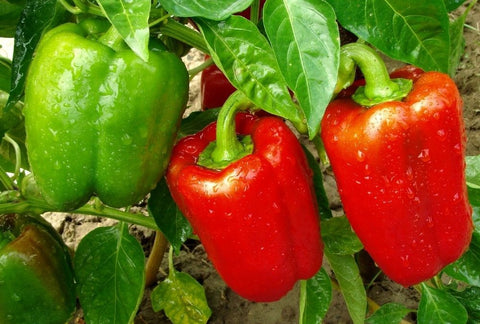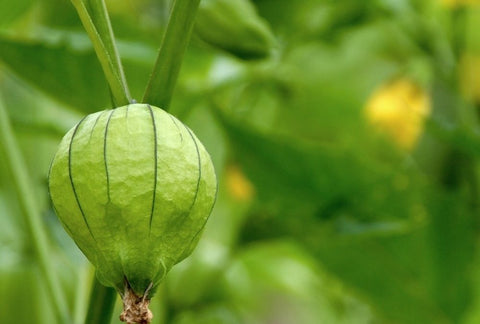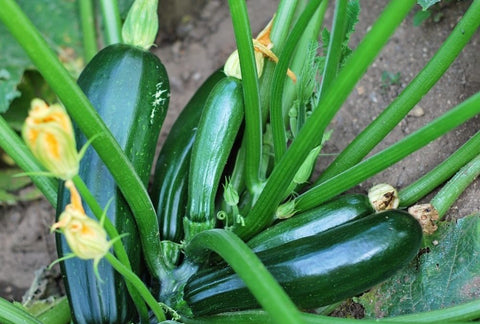Peppers range in heat from 0 Scoville Heat Units (Bell Pepper) to more than 2,000,000 SHU (Trinidad Moruga Scorpion) – so no matter what your taste preference is – there’s a pepper for you!

Timing
Sprouts in 2 weeks. Harvest from Month 3+ on.

Full sun
Equivalent of 7+ hours of direct sun [DLI of 21+ mol/m²/day].

Care
Beginner friendly. You’ll sprout, thin, prune, and harvest.
How to Grow Peppers Inside:Best Pepper varieties to grow indoors
There are over 50,000 types of peppers, and luckily successfully growing pepper plants indoors isn’t too variety-specific. If you’re just getting started, here are our 5 types that work especially well.
Carmen
It’s chopped for salads, sliced for sandwiches, or diced for soups. They’re also delicious raw, so try them as a side for dips
AmazonMini-red stuffing pepper
They have thick, red flesh that is very sweet and great for stuffing.
Urban LeafSweet Heat
Delicious both raw and cooked, Sweet Heat is the perfect pepper for antipasto, grilling, roasting, or simply snacking.
AmazonAce Bell (Ultra Short bell)
This early maturing plant produces heavy yields of red sweet bell peppers. Perfect for salads, frying, grilling, roasting, and stuffing.
AmazonBig Jim (Jalapeno)
It has a mildly spicy flavor and is great for chiles rellenos because of its size. They could also be used in salsa or in salads.
AmazonBest Setup for Growing Pepper Indoors
You’ll need:
Planter:
Ceramic Self Watering Planter (preferred) or pot that is at least 8″ / 1 gal.
Soil:
Standard Potting Mix
Plant Food:
At the start: Herb Blend. This should be high in nitrogen (with NPK numbers like 10-5-5).
Ongoing: Vegetable Blend. This should be high in phosphorus and low in nitrogen (with NPK numbers like 4-10-6).
Grow Light:
A strong grow light that can give the equivalent of 7+ hours of direct sun [DLI of 21+ mol/m²/day].
Jump to: Our product recommendations
Preparing your Planter & Watering Schedule for Pepper
Pepper plants do well in moist soil conditions. If the soil dries out completely the roots will die back and it will be tough for the plant to recover. On the other hand, if the roots are exposed to standing water for too long, they can rot.
A Ceramic Self Watering Planter filled with a standard potting mix self-regulates to keep the soil at consistent moisture for your plant to thrive (and no watering guesswork for you).
To set one up:

- Fill up the planter with dry soil from the bag, gently tamping down the top.
- Dump the soil into a large mixing bowl and add water until the soil is moist, but not sopping wet (about ½ Cup)
- Mix in 1 tablespoon of the Herb Blend Plant Food.
If you are using a regular pot instead, it should be a little bit bigger (at least 8″ / 1 gal and will need drainage holes to prevent it from being over watered. Let the top of the soil dry out between watering.
Starting your Pepper: Seed vs Cutting vs Nursery Plant
New Pepper plants can be started from seed, propagated from an established plant, or purchased live at many garden centers. We prefer to sprout from seed or propagate from a stem cutting, as it results in plants that are adapted to your growing conditions and limit the chances that you accidentally bring home pests.)
How to Plant Pepper seeds

Pepper grows quickly from seed. Plant 1 site in an 8″ / 1 gal container. In larger containers, space sites 8″ apart. For each site plant 2 seeds 1/4 inches deep. Keep the soil warm ( 80-90°F, ideally 70°F). Sprouts typically appear in 10 days but can be as quick as 7 days or as long as 15 days depending on your conditions.
Propagating Pepper: How to Clone from a Stem Cutting

If you’ve already got a Pepper plant you love (or a friend does!) you can easily “clone” it with just sharp scissors and a clean glass of water. First, cut a couple 6” shoots of new growth (avoid anything woody). Next, remove the lower leaves, so the bottom half is just stem. Place in a glass of 3” of water, making sure the cut leaf spots are underwater. Place the glass on a bright windowsill and change the water every few days. In a couple of weeks, roots should emerge and you can transplant them into your container. While using additional rooting hormones won’t hurt, it’s not necessary with Pepper plants.
- Cut 6” section of new growth
- Remove leaves halfway and place them in the water on a sunny window sill
- Wait 14 days for a few ½ inch roots to form and carefully transplant into it final container
How to Transplant Pepper

Live starter plants give you a big jump start on your first harvest. When you’re in a garden center – pick the bushiest plant available (tall and lanky ones will be weak growers) and give it a good inspection for pests. Leaves should be dark green without holes, spots, or curled edges. A best practice is to actually “quarantine” your plant for about a week after bringing it home to make sure it’s free and clear of ride-on pests.
Ensuring it’s pest and disease-free it’s time to transplant your seedling into its final home.
- Remove some soil from its final planter – leaving enough space for the bottom of the seedling to be just higher than the soil surface.
- Hold on to the base of the stem with one hand, and turn the pot over while gently pulling the seedling. Giving the pot a few squeezes can help dislodge it.
- Place in its final container and fill around it with soil so that it’s tight, but not compacted.
Where to grow your Pepper plants
Pepper plants have the highest light needs of any plant – so unless you have a totally unobstructed southern-facing window and plan on only growing in the summer – you’ll need a grow light. We still recommend taking advantage of your bright window (sunlight is free and great for plants!) and supplement it with a grow light. For an introduction to grow lights, head over to our post on grow lights for indoor gardeners. We’ve also got a buying guide for screw in types, but to keep things simple in this guide, we’ll just provide directions for the 24W Screw in Bulb by Sansi, which we think is a good middle-of-the-road option.

How bright should your grow light be?
Pepper plants need the equivalent of 7+ hours of direct sunlight [DLI of 21+ mol/m²/day] to grow their best. In order to provide an equivalent amount with a grow light, it needs to be pretty bright! The 24W Sansi bulb should be placed 6 inches away from the top of the plant. This will give your PPFD (the standard measure of brightness) of 500 μmol/m²/s.
How many hours per day do your Pepper plants need under a grow light?
Pepper plants are what’s known as “day-neutral” so can grow under a range of daylight lengths. In order for them to get enough light, we recommend setting up a timer to leave it on for 14+ hours per day.
Can You Grow Peppers Indoors during Winter?: Pepper Plants Grow Faster in Warmer Temps
Pepper plants are called “warm-weather crops” and like temperatures right around 75. To answer your question about how to grow peppers in winter – they will grow fine in conditions between 55 and 80°F but can lose their fruit if it drops below 40, so we do not recommend growing them during winter. On the other hand, if they are too hot, they will drop their blossoms, wilt, and stop ripening. Most homes are in a good range – and a south-facing sunny window can help get a plant the extra heat if needed.
Week 2: Check for Sprouts
You could see seedlings in as little as 7 days (though 10 days is more typical). If it’s been 15 days and you still don’t have any sprouts, it’s likely that your setup is too cold.
Week 3: Thin Your Seedlings

Thin your planter to only have 1 seedling per site – leaving the largest plant. If you are using the reccomended planter (at least 8″ / 1 gal) this will mean you’ve got 1 plant after thinning. By getting rid of the smaller seedlings, you’re allowing the biggest and strongest one to flourish by reducing its competition for water, food, and space.
If your seedlings are under 2 inches, stretching out, or folding over, it’s likely that they don’t have quite enough light.
Week 4: How to Prune and Trellis Pepper Plants

You don’t need to do any pruning outside of removing yellowing leaves, although you may want to cut certain parts back to fit your space. Pepper plants generally grow as bushes and can support themselves – but if they are looking weak they can benefit from a stake along the main stem.
Month 2+: How to Pollinate Your Pepper Flowers

In order for a flower to turn into a strawberry, it needs to be pollinated. Outdoors, insects and wind move pollen around. Without those, the indoor gardener sometimes needs to step in. To help them out, wait until the flowers open then just give them a slight shake or “rub the nose” of the flower. After the flowers form, it generally takes 4 to 6 weeks for strawberries to reach their full, ripe size.
Month 3+: How to Harvest Peppers
All peppers will first come in green – and they are totally harvestable at this stage. For the next month or so, they will develop their color, and depending on the variety their sweetness or spiciness.
Year 1+: End of Life
Peppers are a perennial so they keep producing for years as long as you give them more soil, nutrients, and proper care.
Shop This Blog
The right supplies can take the guesswork out of caring for your plants – and turn care from a daily to weekly routine. Through our grow tests, we’ve found these products to produce the best indoor Pepper (and also have simple maintenance). Plants are adaptable and can grow in many different conditions, so they are by no means necessary if you already have other supplies.
Best Containers for Pepper: Ceramic Self Watering Planters
Plants thrive on consistent moisture but can suffer if they’re waterlogged. A semi-porous ceramic self regulates ideal conditions. Our favorite is the COSWIP planter. Runner up is XS Self Watering Planter by Wet Pot.
Best Soil for Pepper: Standard Potting Mix
Pepper likes a rich and moist root zone – so you are best off with a standard potting mix – we like this Organic Mix by Espoma.
Best Nutrients for Pepper: Balanced Blend followed by Vegetable Blend
Pepper likes to start with nutrients that are high in nitrogen (with NPK numbers like 10-5-5). For this Herb Blend, we recommend: Joyful Dirt All Purpose
Once they are growing, it’s better to use plant food that is high in phosphorus and low in nitrogen (with NPK numbers like 4-10-6). For this Vegetable Blend, we recommend: Joyful Dirt Tomato & Herb
Best Light for Pepper: DIY or Soltech
There is a very small chance that you have the bright windows needed to grow these without a grow light. If you are looking for a higher-end option – we love the Aspect Light by Soltech. For a more affordable option, a DIY setup using a 24W Screw-in Bulb by Sansi with a Clamp Light and Mechanical Timer works well too. Check out our complete guide on a DIY setup for less than $40 or our buying guide for screw in bulbs.









There are no comments for this article. Be the first one to leave a message!